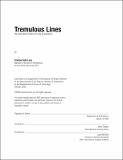Tremulous lines : the alternative history of a site of exception
Author(s)
Solis Loza, Cristina.
Download1236905421-MIT.pdf (41.17Mb)
Alternative title
Alternative history of a site of exception
Other Contributors
Massachusetts Institute of Technology. Department of Architecture.
Advisor
Hans Tursack.
Terms of use
Metadata
Show full item recordAbstract
By the end of World War II, there were 7 standing border walls in the world. By the time the Berlin Wall fell in 1989, there were another 15 walls. Since its destruction, another 20,000km of walls have been erected to divide the world. Today, fathomless quantities of wire, concrete, steel, sand, stone, and mesh now shape the 77 barriers that currently define the otherwise imaginary lines that fracture the world.1 Their construction breaks the continuity of time, creating a rupture in the landscape and a series of unnatural asymmetries that affect both nature and society. What might be envisioned by political actors as a fixed "line on the ground" is anything but. These lines are of tremulous nature, stones may be moved, glaciers will melt, and walls will likely be breached or simply removed. This thesis protests the border as an absolute and static division through the speculation of an alternative history that reimagines a site that straddles two nations. The project argues for contemporary monumentality as an architectural expression to resist the provisionality and marginality of the people who exist there. The monuments expand their impenetrable form to something that can hold a civic program, becoming a catalyst for an ever-changing quasi-urban condition on the borderline.
Description
Thesis: M. Arch., Massachusetts Institute of Technology, Department of Architecture, February, 2020 Cataloged from student-submitted thesis. Includes bibliographical references (page 79).
Date issued
2020Department
Massachusetts Institute of Technology. Department of ArchitecturePublisher
Massachusetts Institute of Technology
Keywords
Architecture.